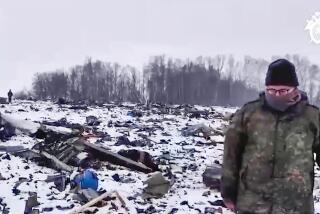Hijackers Free 12, Fly to Algiers : Assurances Reported That Rest of Hostages, Plane Will Be Released
- Share via
LARNACA, Cyprus — A hijacked Kuwaiti jumbo jet flew to Algeria early today after the terrorists who commandeered it eight days ago freed another 12 passengers in exchange for fuel at Larnaca airport.
The giant blue-and-white Kuwait Airways jetliner, its departure delayed by last-minute technical difficulties with two of its engines, took off at 1:17 a.m., almost eight days to the hour after it was hijacked over the Arabian Sea by Shia Muslim extremists seeking the release of 17 fellow Shias jailed in Kuwait.
The airliner landed at Algiers airport shortly after 3 a.m. local time after its nearly four-hour flight across the Mediterranean, wire services reported.
Armed With Pistols
The hijackers, who are believed to number eight gunmen armed with pistols and hand grenades, vowed in a statement read over the cockpit radio before their departure to “continue our journey until our demands for the release of the 17 in Kuwait (are met).”
The plane’s departure followed a day that began on a grim note. At one point the terrorists announced that they had renamed the airliner “The Plane of the Great Martyrs” and said they had put on their “death shrouds.”
Still on board the Boeing 747 are 32 hostage passengers and crew, including three members of Kuwait’s ruling Sabah family.
Cypriot authorities said they had been given assurances that the remaining hostages would be released and the plane handed over in Algiers, where the bizarre and bloody drama is expected to end under the terms of a deal negotiated by the Palestine Liberation Organization.
“We were assured they would be freed in Algeria,” Cypriot Interior Minister Khristodoulos Veniamin told reporters. “We have assurances from the Algerian government as well.” Another government spokesman said the understanding also included the plane.
However, Associated Press quoted one of the hijackers as saying by radio just before takeoff: “We deny what has been reported . . . that we are ready to hand the plane to anyone. We refuse to do that, until martyrdom.” He did not mention the hostages.
The 12 passengers freed three hours earlier included two Palestinians of Jordanian nationality the hijackers said they were releasing “as a present to the uprising” in the Israeli-occupied West Bank and Gaza Strip.
The others, whom the hijackers called “a present to the Cypriot government,” included Kuwaitis, Jordanians and Egyptians. The hijackers said they freed them either because they are ill or poor or have families with many children.
Ambulances Were Waiting
The freed hostages began descending a mobile staircase beside the plane, parked at one end of Larnaca’s lone runway, at about 10:25 p.m. One had to be assisted, but the others walked slowly to three waiting ambulances, their flashing red lights casting an eerie glow over the darkened tarmac.
A doctor at the Larnaca hospital where the passengers were taken said most were suffering from shock, exhaustion and dehydration brought on by the physical and emotional strain of their ordeal. Some were sedated after they arrived, the doctor said.
The on-board air conditioning units continually malfunctioned during the five days that the plane sat in the Mediterranean sun at Larnaca’s seaside airport, and temperatures in the cabin exceeded 95 degrees in the afternoons.
Little was immediately known about the agreement reached with the hijackers, worked out in repeated plane-side negotiating sessions between the gunmen and a joint Cypriot-PLO delegation.
If the terrorists surrender in Algiers, it was not immediately clear what Algerian authorities will do with them. They hijackers shot and killed two of their hostages, both identified as Kuwaitis, while on the ground at Larnaca to press their demands for fuel.
Algeria was once a haven for hijackers but is so no longer, and diplomats said they doubt that the Algiers government would want to be seen as abetting terrorists.
Spotlight as Mediator
Nevertheless, Algeria again finds itself in the spotlight as a mediator and expert in ending international crises.
The North African Arab country helped end the longest hijacking on record in July, 1985, when Americans were released from a TWA jet in Algiers before it was flown to Beirut.
Algeria also received the American hostages from the U.S. Embassy in Tehran when they were released after 444 days’ captivity in January, 1981.
As the Kuwaiti jumbo jet lifted off from the tarmac here, a number of puzzling questions remained concerning the hijackers’ identities, the deal that was struck with them and the possible involvement of others in the seizure of the plane.
There was, for instance, no immediate explanation as to why the Cypriot government appeared to have suddenly retreated from its demand--maintained even after the two passengers were killed--that the hijackers release all their hostages before the plane would be refueled.
Earlier in the day, when the negotiations still seemed deadlocked, PLO Chairman Yasser Arafat told reporters in Kuwait that he had been in touch with the “leaders” of the hijacking in an effort to win the hostages’ release. He did not identify them, but he strongly implied they were not on board the plane.
Arafat said that the hijackers, while at Larnaca, were “receiving instructions from their leaders,” possibly “by radio,” and that this may have accounted for what were said to have been several abrupt changes in their attitude during the tense negotiations.
‘Then the Whole Mood Changed’
At one point, the talks appeared close to success, “and then the whole mood changed because of outside orders,” Arafat said.
He appeared to be referring to the intensive negotiations that took place Sunday night and early Monday morning, when a Cypriot government spokesman implied that an agreement to free all the hostages was close at hand.
Several hours later, however, the terrorists rejected a written proposal that the negotiators had obviously expected them to accept. They set another deadline for refueling and murdered their second hostage--the first was killed Saturday--when the Cypriots continued to refuse them fuel.
Some reports have suggested that the terrorists, who are believed to be Lebanese Shia Muslims, are closely connected to Iran. Their first stop, in fact, was the northeastern Iranian city of Mashhad, where they flew the airliner after hijacking it, early on the morning of April 5, with 112 passengers and crew members aboard, on a Kuwait-bound flight from Bangkok. While in Mashhad, they released 57 non-Kuwaiti hostages, then three days later flew on to Cyprus.
Iran Denies Connection
Iran has denied any connection with the hijackers, but the Iranians are known to maintain close ties with extremist Shia Muslim groups in Lebanon that are also demanding the release of the 17 prisoners in Kuwait.
Whoever was behind the hijacking, the agreement reached at Larnaca appeared to have the consent of Kuwait, which said it had contacted Algeria to ensure that the jetliner would be allowed to land in Algiers.
The Kuwaitis have steadfastly refused to release the 17 Shias, convicted of complicity in the 1983 bombings of the U.S. and French embassies in Kuwait; and the emirate’s foreign minister, Sheik Sabah al Ahmed al Sabah, reiterated that refusal in strong terms Monday night.
“Kuwait is unshakeable,” the sheik told reporters following an emergency Cabinet meeting. “It has suffered a lot from terrorism and will not bend to any pressure of this kind.”
The breakthrough in negotiations appeared to come late Tuesday. In contrast, the morning had begun on an ominous note, with the hijackers releasing a chilling statement that suggested they were about to blow up the plane unless they received more fuel.
‘Death With Glory’
Declaring that “death with glory is better than life in darkness,” the hijackers threatened to “martyr” themselves and their hostages unless their demands for fuel were met.
Referring to the Kuwaiti Cabinet meeting that rejected their demands, the hijackers said, “We too have held a Cabinet meeting on the plane . . . and have decided to put on our death shrouds under our clothes.
“Either our 17 brothers are returned to us or we shall join the ghosts in heaven,” they said in a statement read to the control tower.
They renamed the aircraft “The Plane of the Great Martyrs” and afterward insisted that the control tower address them by that name in all further communications.
There were moments of extreme tension throughout the day--such as when a Greek air force C-130 transport plane with camouflage markings landed at the airport during the afternoon to pick up the families of Greek officers serving in the Cypriot national guard.
The C-130, making its regular weekly run into Larnaca, came in for a landing right over the hijacked jet and taxied across its line of sight to a nearby hangar.
‘OK, Best Regards’
One of the hijackers became agitated and demanded to know what the plane was doing there. He seemed to accept the control tower’s assurances, however, and signed off the radio by saying, “OK, best regards.”
But there were also more comical moments, bizarre because of the grim circumstances.
As an example, there was this exchange between the hijackers and the control tower over an order for lunch.
“Plane of the Martyrs from control tower: Can I take your order?” the Cypriot air controller asked.
“Yes, one omelet, one piece of bread and one beverage,” a hijacker replied.
“Plane of the Martyrs, will that be a cheese omelet or a plain omelet . . . a hot or a cold beverage?” the control tower inquired.
“A plain omelet and a couple of different beverages will do,” the hijacker replied, adding: “And make that for 50 persons. Plane of the Martyrs out.”
More to Read
Sign up for Essential California
The most important California stories and recommendations in your inbox every morning.
You may occasionally receive promotional content from the Los Angeles Times.










